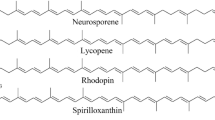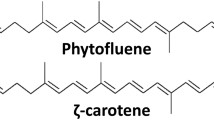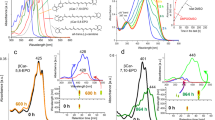Abstract
The singlet oxygen quenching ability of various naturally occurring carotenoids was examined by measuring toluidine blue-sensitized photooxidation of linoleic acid. To assess quenching, the oxidation of linoleic acid was followed by measuring oxygen consumption and ultraviolet absorbance at 235 nm. We found that oxygen quenching increased as the number of conjugated double bonds in the carotenoids increased, but quenching varied with chain structure and functional groups. Acyclic carotenoids enhanced quenching more than did cyclic carotenoids. Conjugated keto groups and the presence of a cyclopentane ring stimulated quenching, while hydroxy, epoxy and methoxy groups showed lesser effects. The photosynthetic bacterial carotenoids, spirilloxanthin and rhodopin, were found to be most effective as quenchers, followed by the cayenne carotenoid, capsorbin.
Similar content being viewed by others
Abbreviations
- PSB:
-
photosynthetic bacteria
References
Davies, K.J.A. (1987)J. Biol. Chem. 262, 9895–9901.
Harman, J. (1956)Gerontol. 11, 298–300.
Das, M., Mukhtar, H., Greenspan, E.R., and Bickers, D.R. (1985)Cancer Res. 45, 6328–6330.
Foote, C.S., and Denny, R.W. (1966)J. Am. Chem. Soc. 90, 6233–6235.
Burton, G.W., and Ingold, K.U. (1984)Science 224, 569–573.
Di Mascio, P., Kaiser, S., and Sies, H. (1989)Arch. Biochem. Biophys. 274, 532–538.
Terao, J. (1989)Lipids 24, 659–661.
Hirayama, O. (1965)J. Biochem. 57 581–589.
Hirayama, O. (1968)Agric. Biol. Chem. 32, 34–41.
Foote, C.S., Chang, Y.C., and Denny, R.W. (1970)J. Am. Chem. Soc. 92, 5216–5218.
Lee, S.H., and Min, D.B. (1990)J. Agric. Food Chem. 38, 1630–1634.
Kobayashi, K. (1970)Kagaku To Seibutsu 8, 604–613.
Author information
Authors and Affiliations
About this article
Cite this article
Hirayama, O., Nakamura, K., Hamada, S. et al. Singlet oxygen quenching ability of naturally occurring carotenoids. Lipids 29, 149–150 (1994). https://doi.org/10.1007/BF02537155
Received:
Revised:
Accepted:
Issue Date:
DOI: https://doi.org/10.1007/BF02537155




